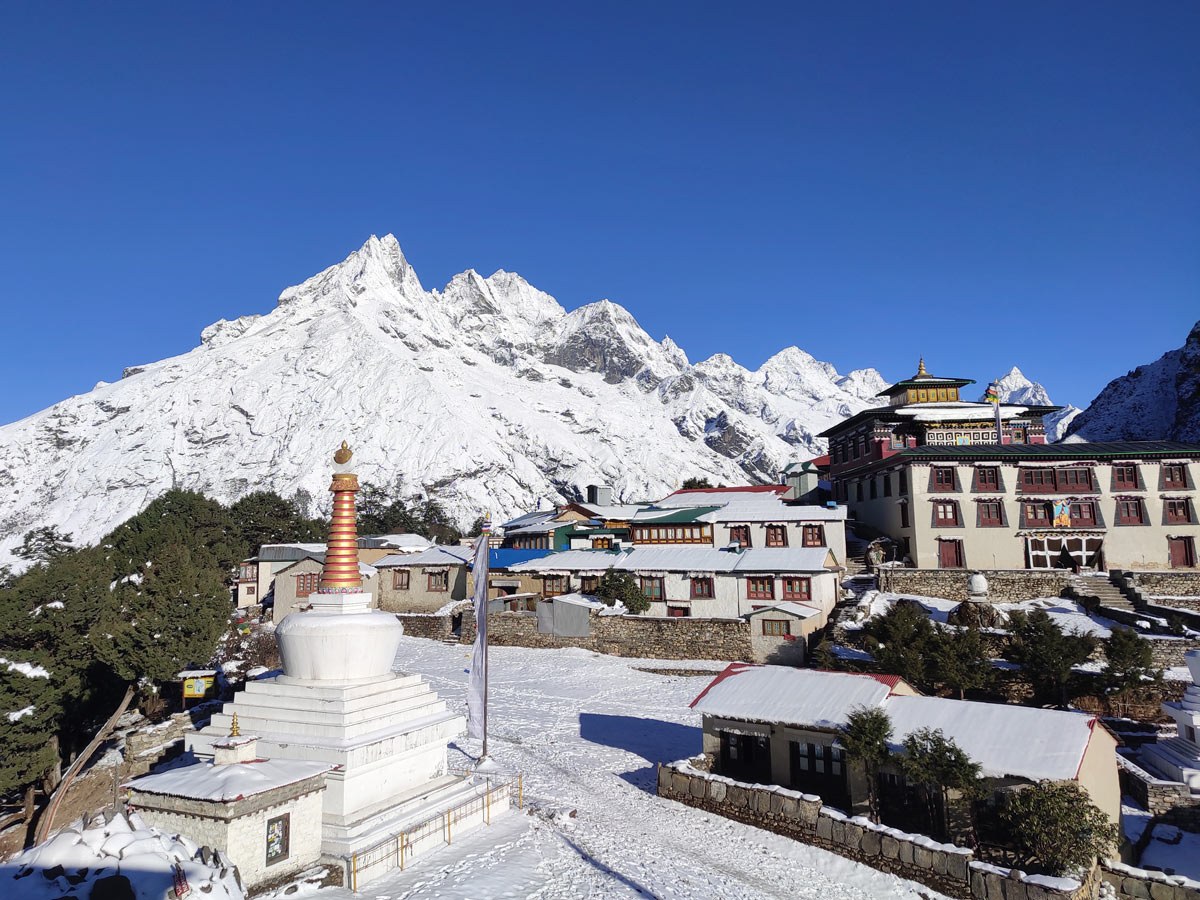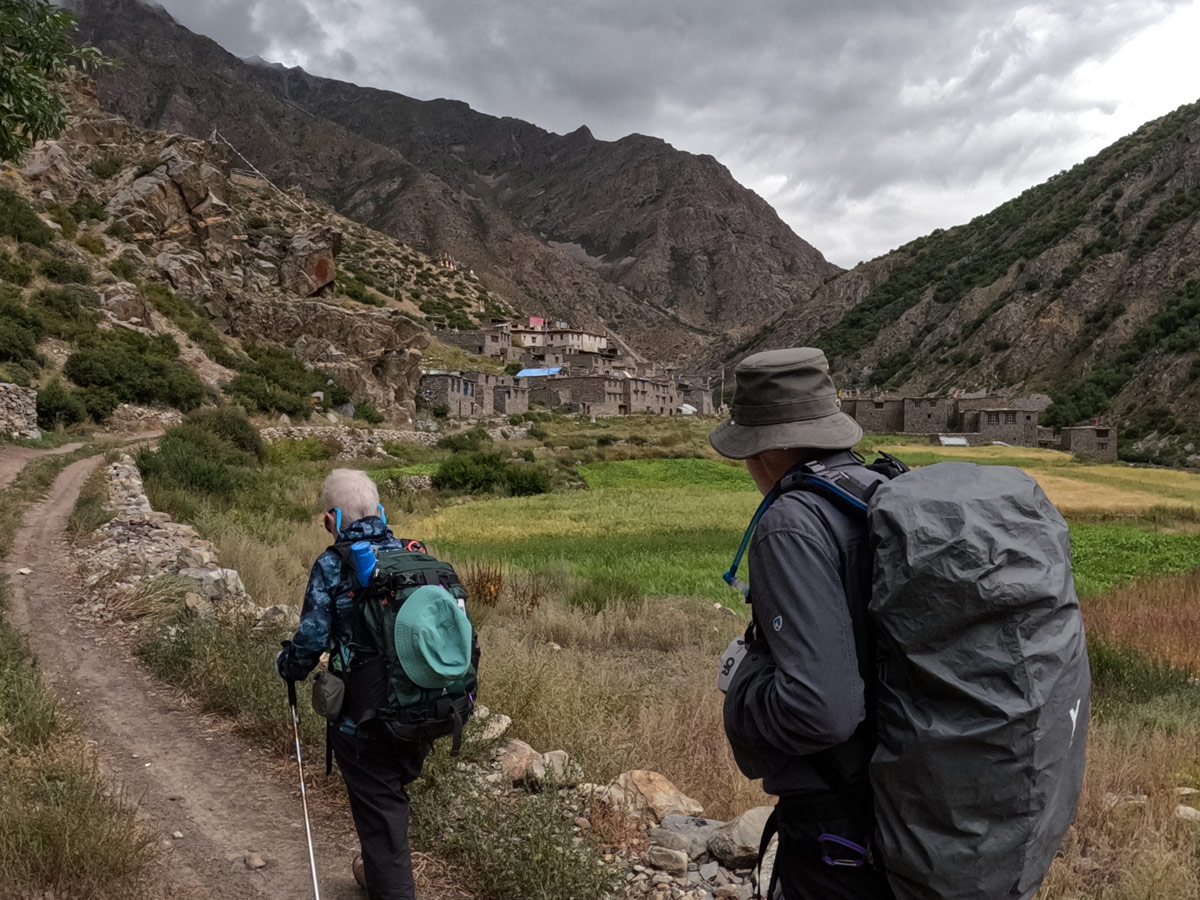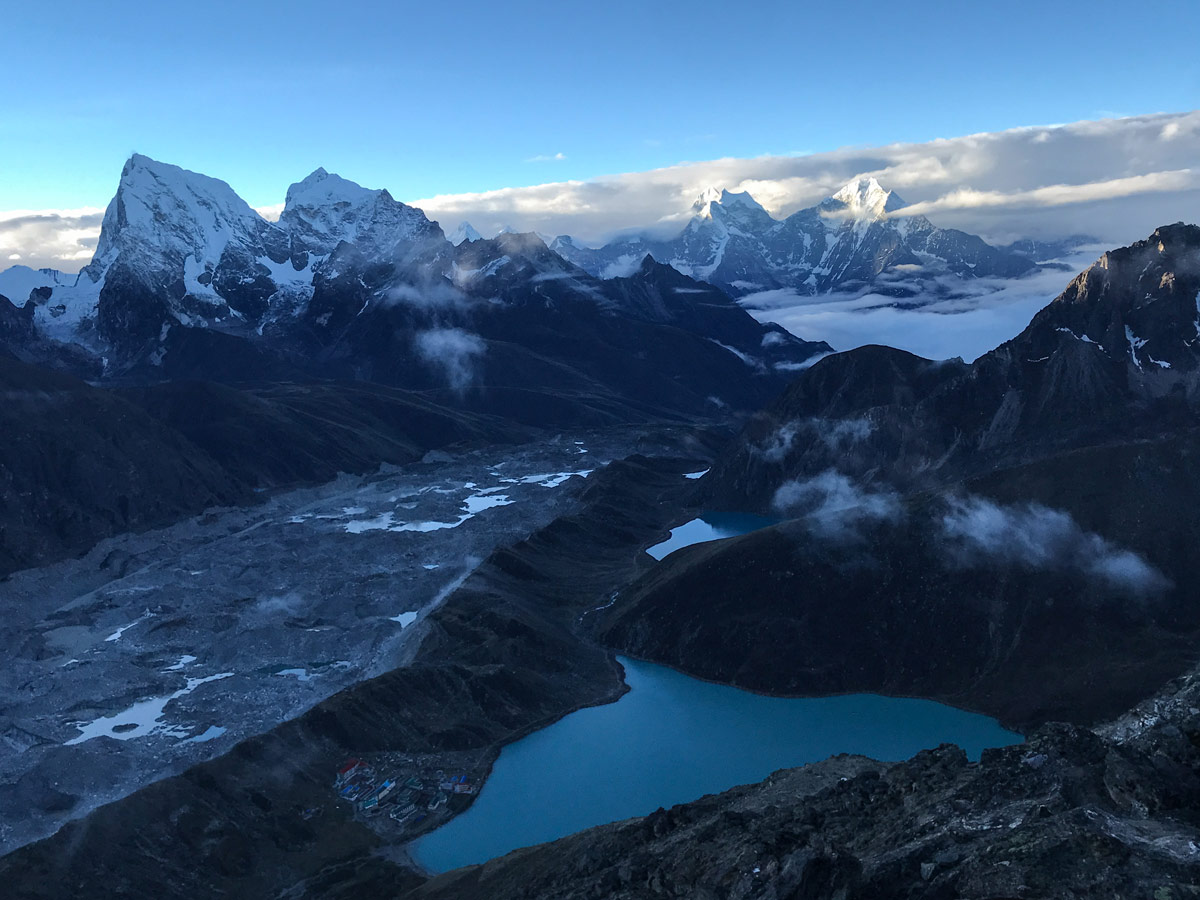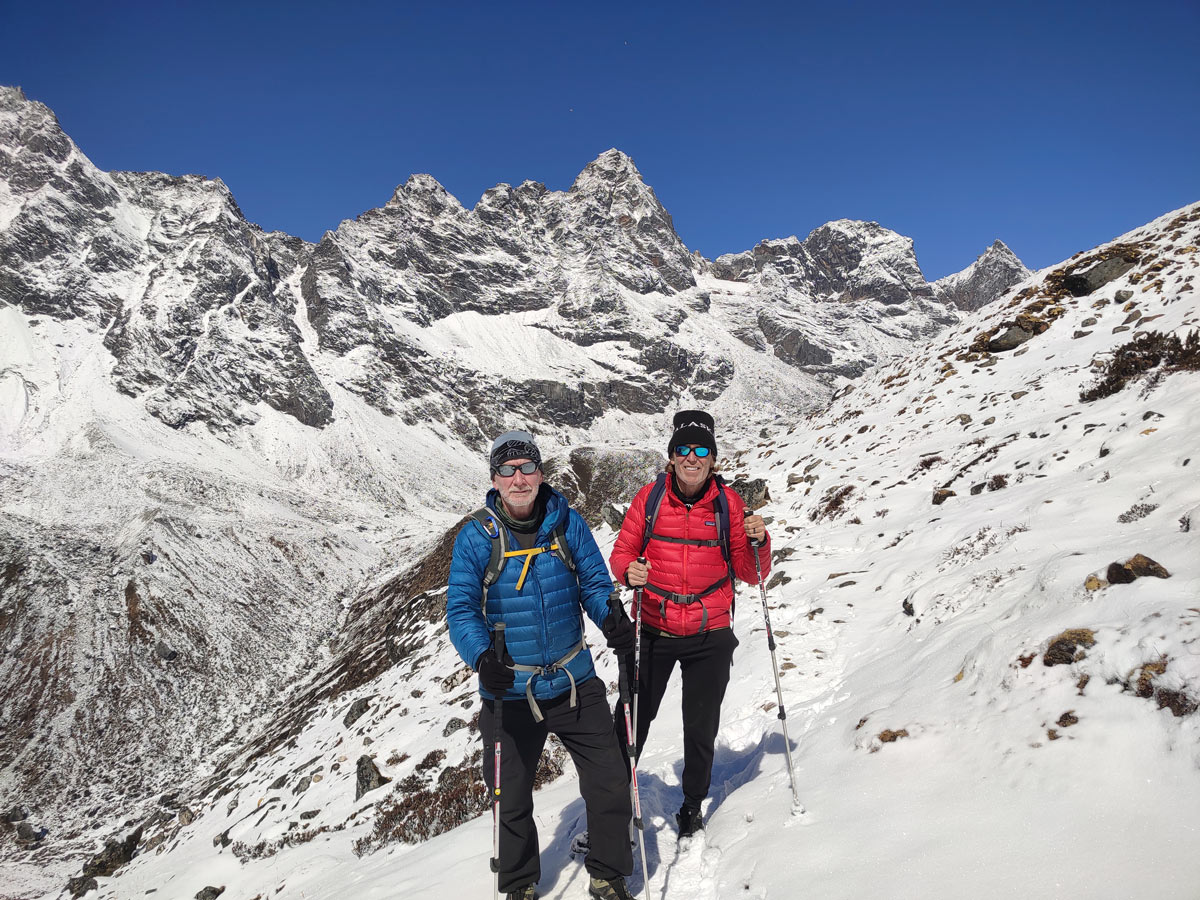Picture yourself standing at an altitude of almost 4,000 meters amidst the fresh crisp air while you take in the majestic view of the Himalayas while the chants and prayers surround you forming a spiritual realm. That is the Tengboche monastery for you!
Also known as Dawa Choling Gompa or Thyangboche monastery, the Tengboche monastery is a vibrant center of Sherpa culture and spirituality nestled amidst the high altitudes of the Himalayas in the Khumbu region at 3,860 m.
This monastery is located at the end of a spur across from the Imja River in the Sagarmatha National Park. It is a major highlight of the region and a significant part of the iconic Everest Base Camp trek trail.
You can also visit the Tengboche monastery as a part of the Everest Panorama trek. Therefore, it is safe to say that the monastery is a constant stop across several treks of the Everest region.
Let’s delve deep into the historical, cultural, architectural, and spiritual significance of the Tengboche monastery and discover what makes it so special.
The Journey to Tengboche
The Tengboche monastery can be reached as an individual journey and as a part of the iconic EBC trek too as this trek meanders its way through the monastery allowing you time to explore its majesty.
The journey to reach Tengboche is as fascinating as the destination itself. The most frequent route for the trek usually begins after a scenic flight from Kathmandu to reach the most dangerous airport in the world- the Lukla airport.
A thin airstrip perched atop a cliffside at an altitude of 2,840 meters, the Lukla airport is also known as the gateway to the wonders of the Khumbu region. From here on, the trail makes its way through vibrant forests and numerous suspension bridges.
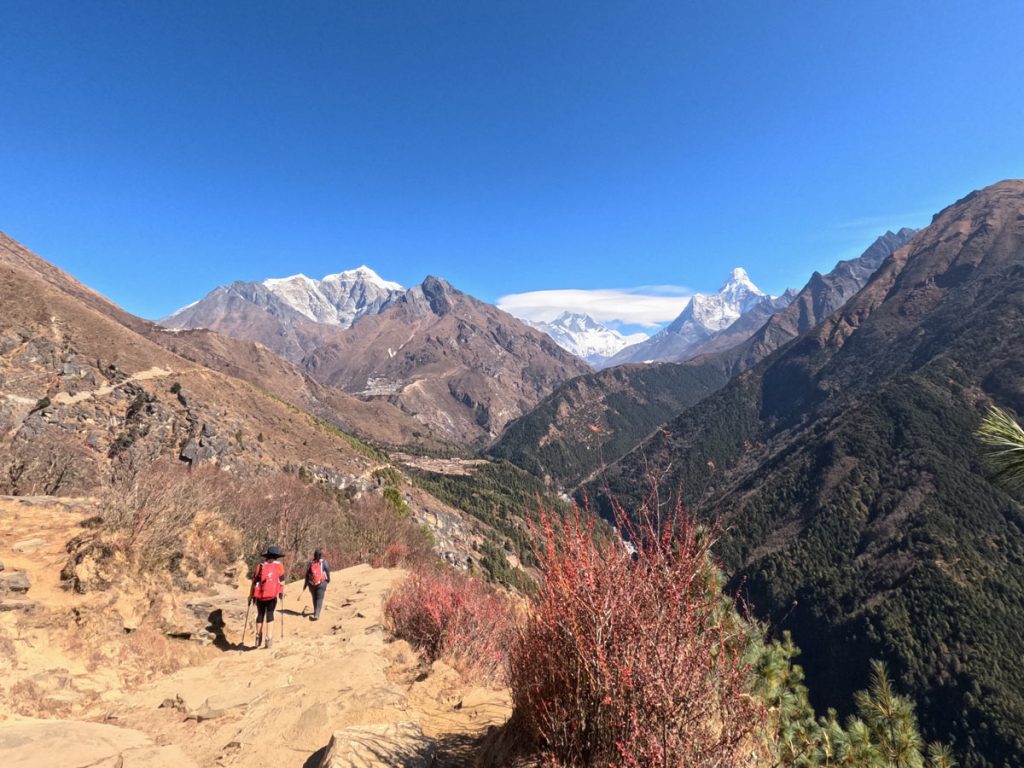
A significant stop during the trek is the Sherpa village Namche Bazaar at 3,440 meters which is bustling as it is the trading hub of the region and also known as the ‘Gateway to Everest’.
Given the high-altitude destination that Tengboche monastery is at, acclimatization is very important to prevent altitude sickness. Namche Bazaar is also important because it is an acclimatization stop where you can adapt to the realm of thin air.
Followed by acclimatization, your scenic journey continues slowly and steadily as you meander through the Dudh Koshi River valley to cross several diverse landscapes and booming rhododendron forests.
After the challenging yet spectacular journey through the gushing waterfalls and serene yak pastures, the majestic sight of the Tengboche monastery perched atop a hill and surrounded by prayer flags greets you as you enter the Tengboche village in Khumjung.
Historical and Cultural Significance
Established in 1916 by Lama Gulu, a renowned Nyingmapa Lama, the Tengboche monastery is the spiritual center of the Everest region and a cornerstone of Sherpa culture and Buddhism in Nepal.
Built first with funding from three local Sherpas, the monastery is also known as the first celibate monastery of the Nyingmapa lineage in Khumbu and it is believed to have a strong connection with Guru Rinpoche.
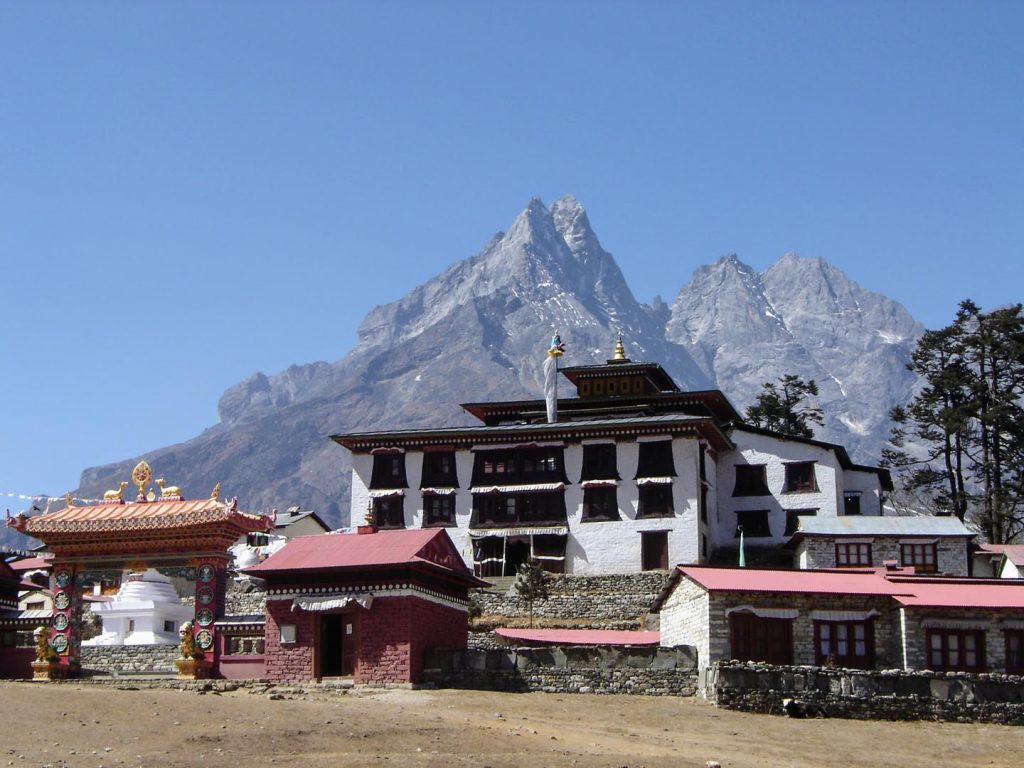
This monastery also shares a deep connection with the Rongbuk monastery in Tibet and features similar architecture and rituals adding a layer of shared heritage to its rich history while linking Tibet and Nepal.
The Tengboche monastery also signifies a spirit of resilience as its history is a combination of devotion and disaster. The monastery has seen a lot of damage since its establishment in 1916.
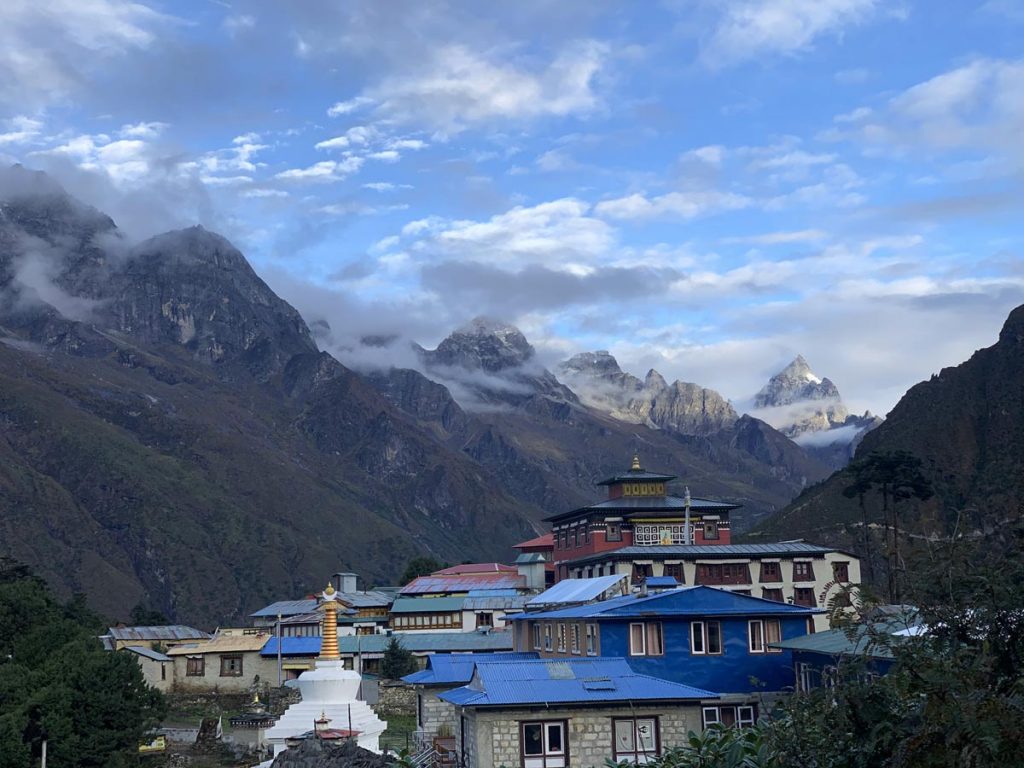
It was destroyed by an earthquake in 1934 and rebuilt. However, a bigger tragedy was when it was destroyed by fire in 1989, engulfing almost all of its priceless artifacts. But it was built with the help of local and foreign aid.
Along with being a stunning landmark, the Tengboche monastery is also hailed for its rich historical and cultural significance. This monastery is a robust indication of the history, spirituality, resilience, and identity of the Sherpa people.
Major Festivals in Tengboche
The Tengboche monastery is also of high religious significance and it also hosts several festivals throughout the year. The main festival celebrated at Tengboche is the Sherpa festival Mani Rimdu falling around October and November based on the Tibetan Lunar Calendar.
Beckoning devotees from all over Nepal, the Mani Rimdu festival at Tengboche monastery is truly an enriching experience as it teaches about the traditions of Buddhism while being vibrant, joyful, and colorful.
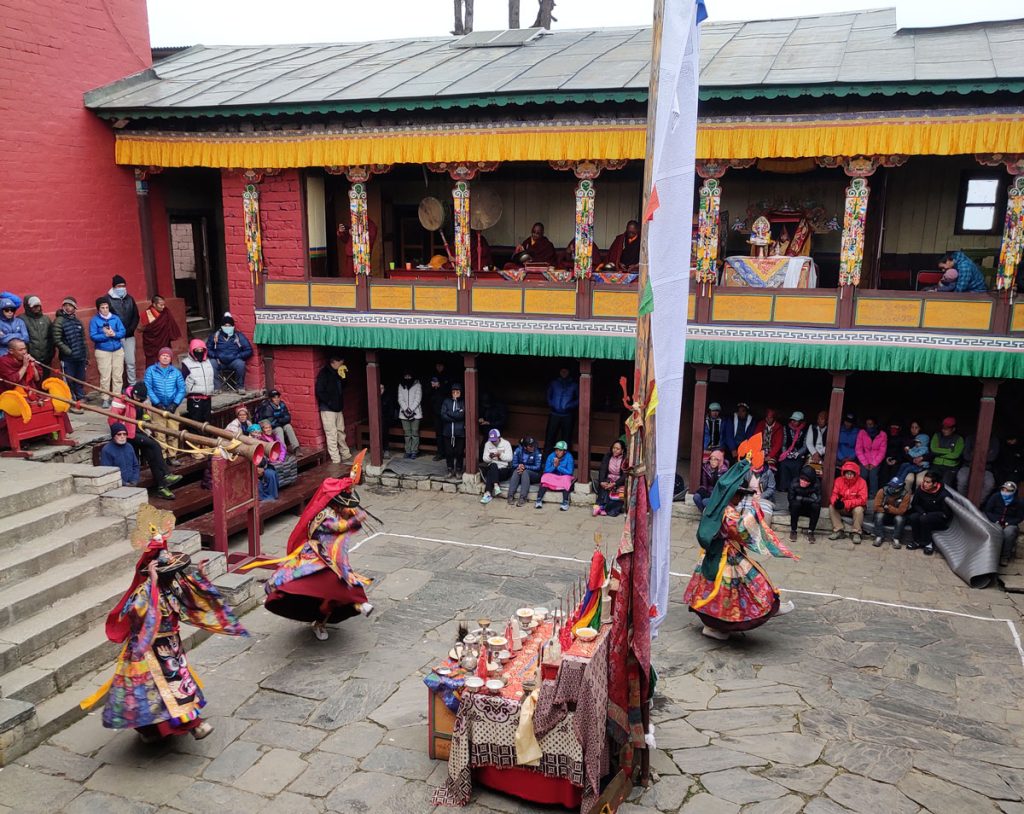
This festival is the oldest festival of the Everest region and it takes place to celebrate the founding of Buddhism by Guru Rinpoche Padmasambhava. It is open for the public only for the last three days.
With masked dances, dramatic reenactments of historical events, and spiritual chanting, the tranquility at the monastery is further enhanced during these 19 days making it a cultural hub of the region.
Besides this, the Tengboche monastery also hosts the Dumje festival to honor the cultural deity of the Sherpas. This significant cultural event takes place during the month of July.
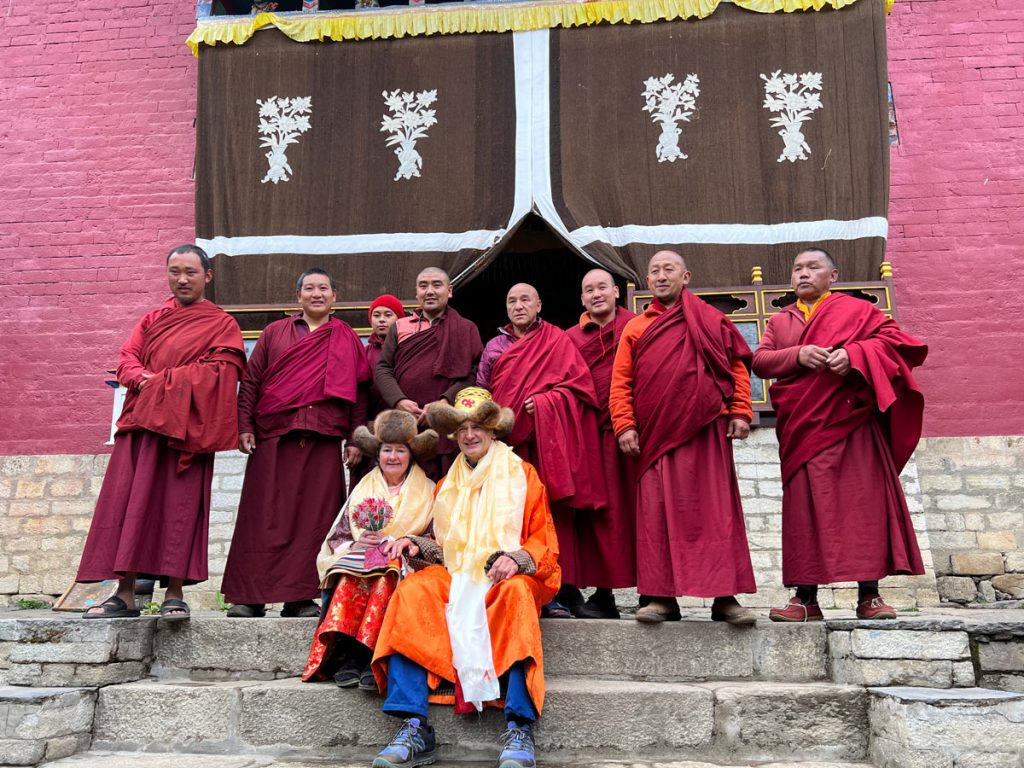
Honoring Khumbila, the festival is marked with several cultural events, rituals, and performances which spreads joy throughout the region.
Other big and small Tibetan festivals like the Tibetan Lhoshar are also celebrated at the Tengboche monastery with equal joy and dedication.
Besides these festivals, visitors can also get married at the Tengboche monastery according to the Buddhist rituals strengthening their union with the positive energy of the monastery!
Architectural Marvel
The spiritual significance of the Tengboche monastery is taken up a notch by its aesthetically pleasing architectural marvel featuring a fusion of Nepali craftsmanship with the traditional Tibetan architectural style.
There is the main structure called ‘Gompa’ located in the center which is surrounded by other smaller buildings. The main structure of the monastery is a three-storied structure with a symmetrical layout reflecting a sense of balance and harmony.
The monastery is made up of a stone foundation and its walls are made with a combination of stones and wood. The walls are thick acting as an insulating layer against the harsh and freezing climate of the Himalayas.
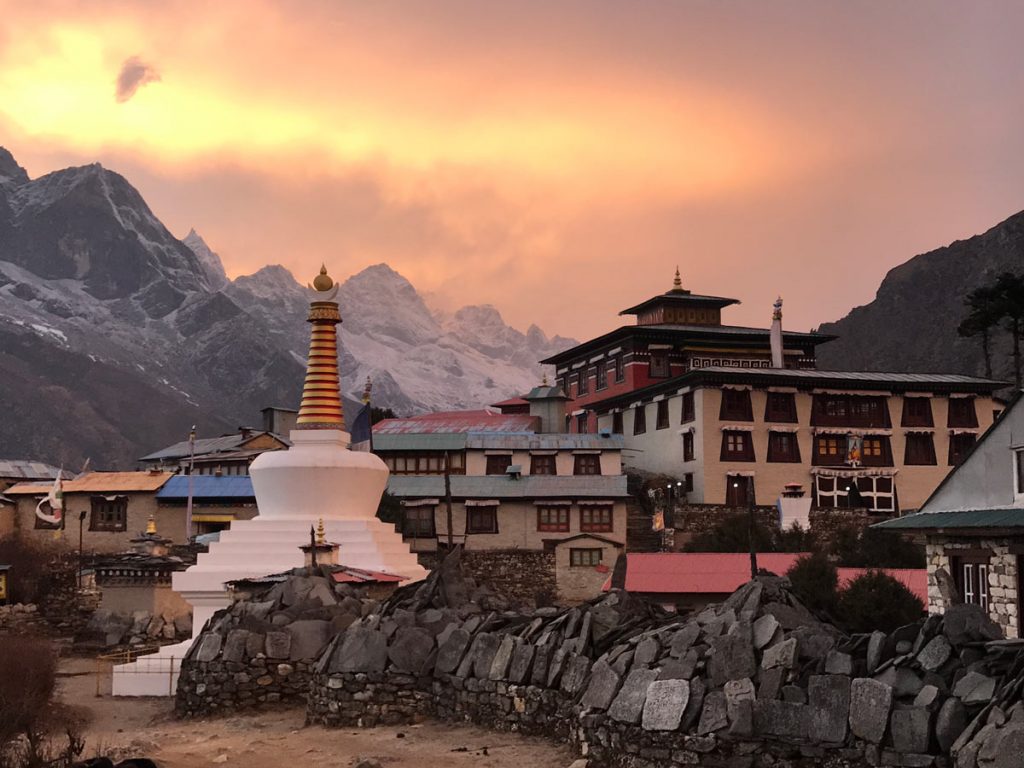
The monastery features a sloped roof built of wooden shingles or tiles with a part of it being clad in shimmering sheets of gold shining bright with the sunlight. The roof is beautiful as well as practical to deal with the heavy snowfall during winters.
The corners of the roofs also have an overhang which along with additional protection, adds to the aesthetic value of the monastery as they are adorned with intricate carvings, murals, and religious motifs.
Exteriorly, the monastery is surrounded by colorful and fluttering prayer flags and prayer wheels, each one of them carrying a spiritual meaning and hundreds of prayers from the pilgrims.
Several mani walls surround the Tengboche monastery with each one having an ‘Om Mani Padme Hum’ engraved which is a sacred Buddhist mantra.
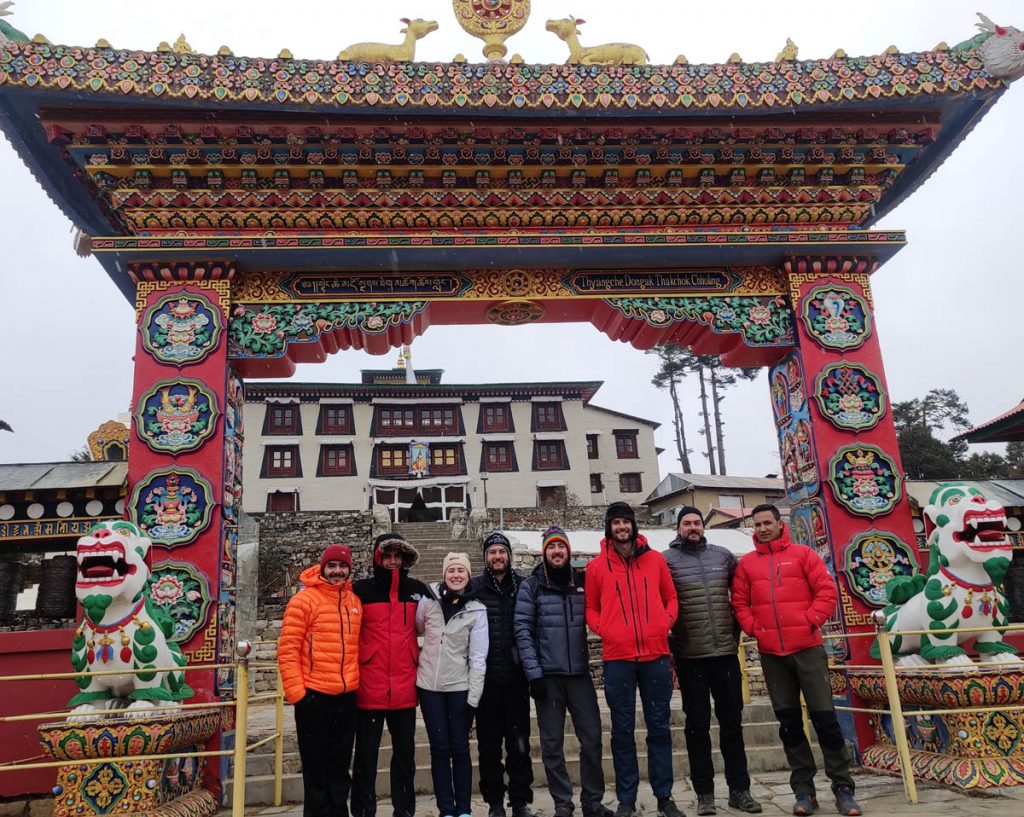
The monastery features an expansive main hall called the Dukhang which is the assembly hall and place of prayers and ceremonies. The walls here are ornate and adorned with exquisite murals representing the Tibetan Buddhist art.
These murals revolve around the happenings of Buddha’s life and that of various deities in the Buddhist pantheon and feature the Jataka tales and mandalas, effectively conveying the lessons of Buddhism.
The main attractions of the Dukhang are the towering statues of the Buddhist deities including a statue of Buddha Shakyamuni in a meditating posture, and statues of significant figures like Guru Rinpoche and Padmasambhava.
The main hall also features rows of benches and cushions for more comfortable communal praying amidst the mighty and beautiful statues.
Besides this, the monastery complex also features the Mani Rimdu Gompa which is a treasure trove of murals and statues.
Other series of buildings surround the monastery which are the residing places of the monks and buildings used for other administrative purposes.
All in all, each and every structure at the Tengboche monastery has some significance along with aesthetic value.
Art and Treasures
The Tengboche monastery is also full of arts which serves both as a source of knowledge and an object of veneration as it enhances the aesthetic beauty along with giving the visitors an understanding of Buddhist philosophy.
It possesses a variety of sacred objects like murals, scriptures, statues, sculptures, or ceremonial items. The walls of the monastery feature several vibrant murals, each depicting some part of the life of Buddha.
Thangkas are another major attraction of the monastery which are either painted or embroidered reflecting any deity, Buddha’s life, or cosmological charts and parts of the universe. These are used during ceremonies and festivals as a sign of devotion.
The statue of Shakyamuni Buddha in the main hall is also an artistic masterpiece being 20 feet in length and adorned with colorful clothing, precious stones, and several metals.
The bells, dorjes, and drums used for regular prayers are ceremonies are also beautiful and reflect some art and symbolic meaning within them.
The monastery also houses several religious texts and scriptures surrounding the religious teachings of Mahayana Buddhism. These scriptures are bound and covered in silk while some of them even have intricate wooden covers with religious motifs.
All these arts are timeless treasures of the Tengboche monastery which are valuable in passing the cultural teachings to the coming generations while acting as a bridge between the mundane and the divine.
Experiencing Local Life
Beyond the majestic Himalayan views and the spiritual experience of Tengboche, the local life in Tengboche is worth exploring too as it gives you a unique opportunity to connect with the Sherpa community and live their everyday reality.
You can stay at local teahouses and lodges which are often simple with basic facilities but comfortable giving you a firsthand experience of the warm Sherpa hospitality.
There you can also get a taste of the mouth-watering local cuisine adapted for the high-altitude environment which includes staples like potatoes, yak cheese, dal bhat (rice and lentils), tsampa (barley flour), dhido, momo, thukpa, other nourishing food items.
If you are planning to spend a day or two at Tengboche village, you can also engage in local activities like tending to the crops, milking the yaks, or simply observing them as a window into the Sherpa way of living.
You can also be a part of any cultural celebration and traditions. Sherpas are very hospitable and friendly and they love sharing bits and pieces of their history, folklore, and their heritage which can also be a unique experience for you.
As you take a stroll in the village, you can also get a taste of the legendary Tengboche apple pie amongst other delicious treats at the Tengboche bakery as you sit amidst the towering Himalayas while facing a majestic view.
Experiencing the local life of Tengboche and interacting with the locals, be it just sharing a cup of tea with them, can truly transform your simple visit into a meaningful exchange of cultures.
Best Time to Visit Tengboche Monastery
The best time to visit the Tengboche monastery is a subjective factor, and it really depends on the purpose of the visit. It can vary for those wanting to witness the mountain majesty of the region and for those wanting to embark on a cultural exploration.
If you are a trekker wanting to make a stop at Tengboche monastery, then you should be visiting the region during the months of autumn (September to November) or spring (March to May) as these are the best times for trekking in Nepal.
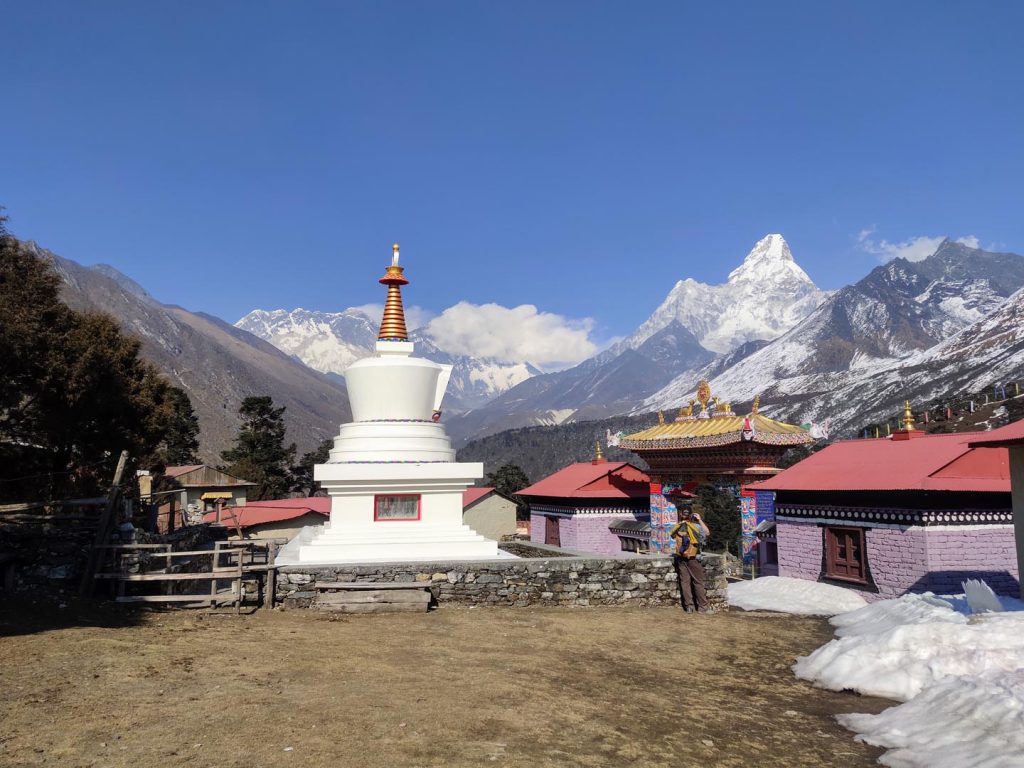
During these seasons, you can complete your Everest adventure without much physical discomfort or seasonal challenges. Also, you can experience the Mani Rimdu festival if you visit the region during autumn.
However, if you want to witness the region blanketed with snow and get the silver panoramas of the surrounding peaks while enjoying your adventure in solace, you can visit the region during winter as there is less crowd here.
Visiting the Tengboche monastery during winters is possible but it is not advised as you might encounter sudden and heavy rainfalls causing inconvenience during your journey.
Travel Tips and Etiquettes
Visiting Tengboche is a journey full of experiences. However, there are certain things that you have to keep in mind to ensure an adventurous journey while being respectful to the cultures and the spiritual value of the monastery.
Trek Preparation
- The best time to visit the Tengboche monastery is the months of spring and autumn as these seasons have the best climatic conditions. You can experience the mountain’s majesty while not freezing out.
- Another perk of visiting the monastery during autumn is that your journey will coincide with the legendary Mani Rimdu festival and you can make the best out of your journey.
- The journey to Tengboche monastery is challenging. Therefore, it is advisable to start preparing well in advance and get into a good level of physical fitness.
- Altitude is a challenging factor of the trek. Therefore, acclimatize well at Namche Bazaar to prevent altitude sickness.
- Obtain travel insurance covering helicopter evacuation in case of any emergencies.
- Hire a local guide and porter as it makes your experience much more convenient while also providing employment in the local community.
Cultural Sensitivity
- Tengboche monastery is a place of high religious value. Therefore, make sure to not offend any locals and learn about the etiquette well in advance.
- Dress modestly while visiting the monastery and avoid sleeveless tops, shorts, tight-fit leggings, and any other clothing that you might not deem fit for the place.
- Remove your shoes while entering the monastery and speak softly as it is a place where monks are constantly meditating.
- Photography might be forbidden in some areas of the monastery. Therefore, you must ask before clicking the pictures and avoid using flash so as to not disturb anyone.
- Learn basic greetings like ‘Namaste’ and greet the monks with a slight bow and hands clasped together as this gesture denotes respect and is considered polite.
- Avoid touching monks and any other religious objects within the monastery premises.
- Attend the evening aarti (prayer) where you get to experience the beautiful butter lamps illuminating the surroundings as the monks chant the prayers.
- Avoid littering in the sacred surroundings of the monastery.
- Receive blessings from the resident Rinpoche who is considered a respected teacher there.
Conclusion
The journey to Tengboche monastery is an adventurous trek as well as a profound experience that might also change your outlook towards life.
Amidst the fluttering prayer flags and chanting of the monks while you are surrounded by the views of mountains like Mt. Everest, Ama Dablam, Nuptse, Lhotse, and more, your experience will be nothing short of transformative.
Besides this, your knowledge regarding the Buddhist culture will also be enhanced along with a small tour of the fascinating murals and thangkas. Therefore, it should be a must-visit destination for you!
